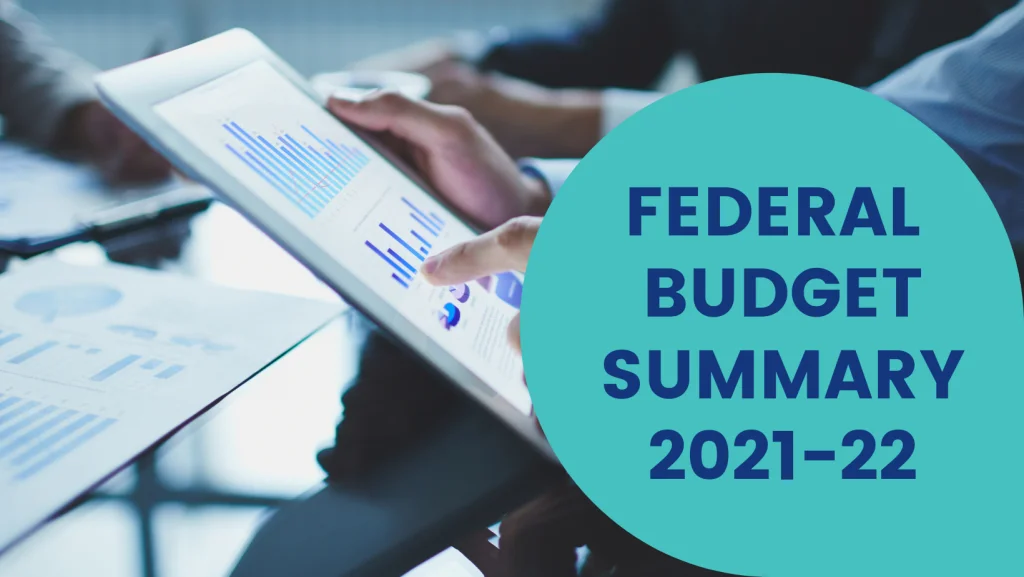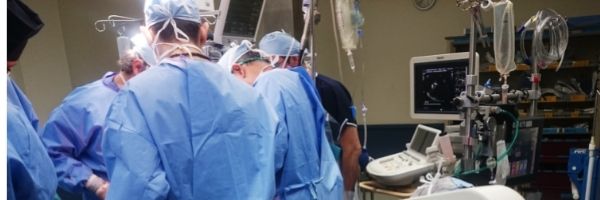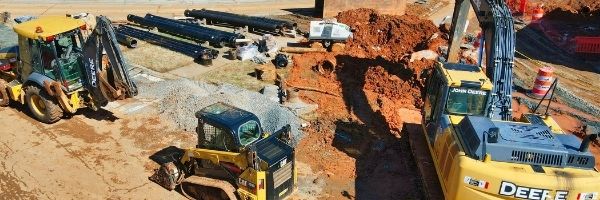
Treasurer, Mr Frydenberg, handed down the Federal Budget Summary 2021-22 on 11 May 2021. The big-spending Budget is aimed at accelerating Australia’s recovery.
Mr Frydenberg said the Australian economy has rebounded at its fastest pace on record over the latter half of 2020. The impact of COVID-19 will see the deficit reach $161 billion in 2020-21, improving to $106.6 billion in 2021-22, before further reducing to $57 billion in 2024-25. JobKeeper has played its role with nearly one million jobs added since May 2020, Mr Frydenberg said.
The Government believes the 2021-22 Budget puts the economy on course for our unemployment rate of 4.75 percent by the June quarter 2023. Real GDP is forecast to grow by 1.25 percent in 2020-21, increasing to 4.25 percent in 2021-22 and 2.5 percent in 2022-23. To achieve these targets the Commonwealth Government has committed $291 billion in direct economic support for individuals, households, and businesses since the commencement of COVID-19. The Budget also adds to infrastructure investment, with a further $15.2 billion of infrastructure commitments.
With regards to personal taxation, the Government confirmed that it will extend the low and middle income tax offset (LMITO) beyond 2020-21. Taxpayers will continue to receive the tax offset (between $255 and $1,080) in the 2021-22 income year. The full Budget papers are available at www.budget.gov.au.
Our Budget Summary covers the below topics. Please click on the link to skip to the summary:
| Personal Tax | Health |
| Business | Aged Care |
| Superannuation | Infrastructure |
| Housing | National Disasters |
| Women | Education |
Personal Tax
-
-
- No changes were made to personal tax rates.
-
-
- Tax cuts of over 10 million for Low and Middle Income Tax Offset will remain in place for the 2021-22 financial year. Individuals will receive up to $1,080, while couples will get up $2,160.
-
- Individual tax residency rules will be simplified and modernised.
-
- The $250, self-education expenses threshold will be removed.
Low and Middle Income Tax Offset (LMITO) will continue to apply for the 2021-22 income year. Consistent with the current arrangement, the LMITO will be received on assessment after individuals lodge their tax returns for the 2021-22 income year.
Self-education expenses will have the first $250 of deductions for prescribed courses of education will be removed.
Business

-
-
- A further $2.1 billion will be provided to support the aviation, tourism, arts and international education industries.
-
-
- Instant asset write-off to be extended.
-
- The temporary loss carry-back measure will be extended for another 12 months.
-
- $1.2 billion to build digital infrastructure, skills and cyber security.
-
- Apprenticeships and traineeships subsidies extended.
-
- Tax for SME’s will drop to 25% and 17% for income from new patents developed in Australia.
-
- Small business to be able to pause disputed ATO debt recovery.
At the start of 2021, the Federal Government announced a $1.2 billion support package for the tourism and aviation sector. With international borders now expected to remain closed until 2022, the Government announced a further $1.2 billion to assist the aviation and tourism sectors. Funds of $274.6 million will go to travel agents, tour operators, business events, zoos and aquariums.
$200 million will go towards International Aviation Support payments to preserve an Australian International airline workforce and operational capability.
Businesses in regional Australia will remain connected to key international markets, with the Government announcing an extension to the International Freight Assistance Mechanism.
The Budget provides around $300 million to assist the successful reopening of Australia’s creative and cultural sector. With a further $25 million being provided to supporting artist wellbeing and regional arts recovery.
The Instant Asset Write-Off scheme will now continue until 30 June 2023. Businesses that have a total income of up to $5 billion can immediately deduct the full cost of eligible depreciable assets which were acquired from 7:30pm on 6 October 2020 and first used or installed by 30 June 2023. Mr Frydenberg said the scheme will ‘encourage businesses to make further investment, including in projects requiring longer planning times and continue to support economic recovery in 2022-23.
The temporary loss-carry back scheme which allows firms with domestic turnovers capped at $5 billion to write off COVID-19 induced losses against previous profits has also been extended for another 12 months until 2022-23. When eligible businesses lodge their 2022-23 tax return, they will be able to offset previously taxed profits from as far back as the 2018-19 income year to receive a tax rebate. The rebate value is limited as the amount carried back cannot be more than earlier taxed profits. Businesses who opt not to use this the loss-carry back measures can still continue to carry losses forward. This scheme is expected to cost $2.8 billion over the next four years.
The Budget promises $1.2 billion over the next six years to assist the Digital Economy Strategy, aimed at making Australia a ‘leading digital economy and society by 2030. Projects include $53.8 million over four years to create a National Artificial Intelligence (AI) Centre and four AI Digital Capability Centre to drive and support small and medium enterprises to adopt and use transformative AI technologies; $33.7 million over four years to provide grants to businesses to work with the Commonwealth to develop AI based solutions to national challenges; $15.3 million over three years to promote and accelerate the adoption of e-invoicing by businesses and all levels of government; $12.7 million to expand the Australian Small Business Advisory Service Digital Solutions program to reach up to 17,000 small businesses; $32.6 million over two years to establish Emerging Aviation Technology Partnerships program to support the use of emerging aviation technologies; $3.1 million over two years to establish New Drone Rule Management System and develop a National Drone Detection Network and $18.8 million over four years for a Digital Games Tax Offset to provide 30 percent refundable tax offset for qualifying Australian digital games expenditure.
An additional $2.7 billion will be spent over four years to expand the Boosting Apprenticeship Commencements wage subsidies. This scheme reimburses employers for the wages of new apprentices and trainees by up to 50 percent. The new measures will mean places will be uncapped and the length of time for the 50 percent wage subsidy will be increased to 12 months. Businesses of any size can claim the subsidies for new apprentices and trainees who commence employment between 5 October 2020 and 31 March 2022. A maximum amount of $7,000 per quarter is available.
The corporate tax rate for Small-Medium Enterprise’s will drop to 25 percent from 1 July 2021. The current rate is 27.5 percent. Income earned from new patents developed in Australia will be taxed at a concessional rate of 17 per cent.
The Government will introduce legislation to allow small businesses to pause or modify ATO debt recovery action where the debt is being disputed in the Administrative Appeals Tribunal (AAT). This measure is intended to provide an “avenue” for small businesses to ensure they are not required to start paying a disputed debt until the matter has been determined by the AAT. Small business entities (including individuals carrying on a business) with an aggregated turnover of less than $10 million per year will be eligible to use this option.
Superannuation

-
- People aged between 67 and 74 will no longer need to pass the work test in order to make after-tax and salary sacrifice.
-
- The eligibility age to make ‘downsizer’ contributions into your super has been reduced from 65 to 60 years of age.
-
- Those aged over 60 can contribute up to $300,000 to their superannuation fund if they downsize their home.
- The minimum Super Guarantee threshold of $450 will be removed.
From 1 July 2022, the work test will no longer be required to be met by individuals aged 67 to 74 for voluntary contributions like non-concessional contributions and salary sacrifice contributions. Individuals aged 67 to74 will still need to meet the work test requirements in order to make any personal deductible contributions.
Currently, these individuals (aged 67 to 74) would need to meet a work test or be eligible for a work test exemption before they can make voluntary contributions to super. Contributions can be accepted up until the 28th day after the end of the month on which they turn 75. The work test is satisfied if an individual was gainfully employed for at least 40 hours over a consecutive 30-day period during the financial year. Individuals aged 65 to 74 will also be able to use the bring forward provisions subject to the available caps and meeting the total super balance criteria. Currently, only those under age 65 on 1 July of a financial year can trigger the bring forward provision in that financial year. The measure that was originally announced in the 2019-20 Federal Budget to extend this age from 65 to 67 effective 1 July 2020 has not been legislated.
Housing

-
- Government to assist another 10,000 first-home buyers to build a new home with a 5 percent deposit.
-
- Some 10,000 single parents to purchase a home with a 2 percent deposit.
-
- First Home Super Saver Scheme will increase from $30,000 to $50,000 for the number of voluntary contributions that can be accessed.
The Federal Budget is aimed at ‘supporting construction jobs and home ownership’ through multiple grants and schemes to ‘help more Australians realise their goal of homeownership.’
Single parents will be given Commonwealth Government assistance to purchase a property under a policy known as the ‘Family Home Guarantee’. Under this policy, the Government will guarantee 18% of a home loan. Enabling property purchases to have only a 2% deposit, without the borrower having to pay lenders’ mortgage insurance. This scheme will be available for 10,000 single parents.
An extension of another 10,000 places for the government’s First Home Loan Deposit Scheme was also announced. Allowing eligible first-home buyers to release voluntary super contributions to put towards a house deposit. From the 1st July 2021, the Government will increase the amount a person can release from their super from $30,000 to $50,000 to purchase a home.
Women
-
 $1.7 billion will be invested into childcare to help boost workforce participation and economic security for women.
$1.7 billion will be invested into childcare to help boost workforce participation and economic security for women.
-
- A new $1.9 billion in funding for women’s safety, to deliver more emergency accommodation, legal assistance, counselling and financial support. Includes $680 million to help prevent domestic violence.
A key measure of the Budget changes to childcare with $1.7 billion over three years, with the spending to come into effect in July 2022. The additional spending is aimed at getting more women into the workforce. It will assist families who have two or more children under the age of five by boosting subsidies for the second and subsequent children by up to 30 percent to a maximum of 95 percent. Currently, childcare subsidies are capped at $10,560 per child for families earning over $189,390. This cap will be removed under the new policy.
$26.2 million has been allocated over four years to protect young girls online including developing software to detect image-based abuse. Funding to help women to access legal assistance was given $129 million. To assist in implementing recommendations from the Sex Discrimination Commissioner’s Resepct@Work Report, $9.3 million has been provided.
Health

-
- $13.2 billion to be spent over 4 years on the National Disability Insurance Scheme (NDIS).
-
- $2.3 billion packages to assist mental health and suicide prevention services.
-
- Medical research to receive $6.7 billion
-
- Improving affordability to Private Health Insurance
-
- A further $1.9 billion was allocated for COVID-19 vaccination roll-out.
Mr Fryenberg announced $13.2 billion to meet the needs of Australians with disabilities. Funding for the NDIS is expected to reach $122 billion in the next four years, this includes State and Territory and Federal Governments contributions. The number of people accessing NDIS is currently 450,000, and this is expected to grow to 530,000 over the next few years. With the cost of spending for NDIS expected to overtake the cost of Medicare within the next three years, it is expected that the Government will look to make changes to the way the NDIS is funded and how the scheme is administrated.
New funding will see every Australian who leaves hospital after a suicide attempt offered at least three months follow-up care. Mr Frydenberg said during his Budget speech that suicide prevention is a national priority especially given that ‘suicide is the leading cause of death in those aged 18 to 44.’ $22 million in funds will support people who are bereaved by suicide. Policies to prevent suicide will be enhanced and will receive $61.6 million over four years. Which will be coordinated by a National Suicide Prevention Office to establish a national strategy.
The Australian Government announced $6.7 billion for medical research over four years. A commitment to providing $228.1 million in new grants and funding programs to assist researchers around the country to tackle health problems such as COVID-19, burn injuries, and silicosis. Other projects include around $12 million to Deakin University for the Mental Health Australia General Clinical Trial Network, $11.9 million to the University of Sydney to establish Growing Minds Australia and $2.4 million to Monash University for the Third Degree Burn Wound Closure.
Mr Frydenberg announced $8.7 million over 4 years to assist in making private health insurance simpler and more affordable for Australians.
Aged Care

-
-
- An additional $17.7 billion over five years to transform the aged care system.
-
-
- This includes $6.5 billion for additional Home Care Packages and $7.8 billion for a new funding model.
-
- $229.4 million will go towards dementia care.
Following the Royal Commission into Aged Care, the Government has unveiled extra home care packages to the tune of $17.7 billion. Eighty thousand extra home care packages will be provided over the next two years. The Royal Commission found that almost 103,000 older Australians were waiting for a package. $630.2 million has been allocated to connect people living in regional areas with aged care services. With an additional $798.3 million to support informal and family carers looking after senior Australians.
Funds of $229.4 million will be put to improving the quality of life and care for people living with dementia.
The Government will spend more than $650 million to upskill and grow the aged care workforce. This includes funding an additional 33,800 training places over two years for personal care workers.
Infrastructure
-
- An additional $15.2 billion to be invested over ten years for roads, rail, and community infrastructure.
These new commitments are expected to support 30,000 direct and indirect jobs around Australia. In Queensland, projects include, $400 million in additional funding for the Bruce Highway; $160 million for the Mooloolah River interchange upgrade; $178.1 million for line capacity improvements on the Gold Coast Rail line from Kuraby to Beenleigh; $126.6 million for stage three of the Gold Coast Light Rail, $400 million for upgrades to the inland freight route from Mungindi to Charters Towers; $240 million for the Cairns Western Arterial Road duplication; $203.4 million for local road and community infrastructure projects and $261 million or road safety projects.
Major projects around the country include $2 billion to support the delivery of the Melbourne intermodal terminal; $2.6 billion for the North-South Corridor in South Australia; $2 billion for the Great Western Highway upgrade from Katoomba to Lithgow in New South Wales and $200 million for the Great Eastern Highway upgrades.
Natural Disasters
-
- $10 billion government guarantee to make insurance more affordable for those living in northern parts of Australia.
-
- More than $600 million for community and household projects to lessen the impact of natural disasters.
-
- $170 million to boost internet and mobile coverage in regional Australia, particularly in bushfire-prone areas.
The establishment of a reinsurance pool for cyclones and related flooding will commence on 1 July 2022. The cost of providing insurance will be lower and savings will be passed on to consumers and businesses in the form of lower premiums.
A pledge of $600 million towards creating a new national agency that will be tasked with helping local communities respond in times of natural disasters such as bushfires, floods and drought.
Education

-
- $2 billion to fund preschools.
-
- More than $19 billion in funding for universities in 2021-22.
-
- $903.5 million will be provided for more places and support for people wanting access to higher education.
Participation in early childhood education programs is a key focus of the Budget. With $2 billion to be invested in delivering preschool funding. The funding will support access for all children to at least 15 hours per week of learning in the year before school.
Non-university higher education providers will benefit from $26.1 million to provide an additional 5,000 Commonwealth supported short courses in 2021.
Next Steps
To get the maximum benefits from the new measures announced in the 2021 Federal Budget, please contact us today to arrange your 2021 Tax Planning meeting via email support@wardlepartners.com.au or phone (07) 5492 0300.




